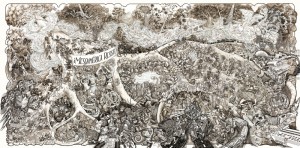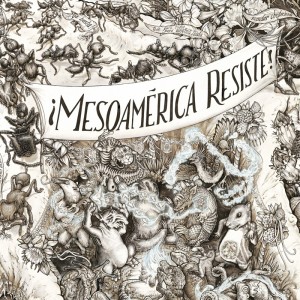Maine Collective of Activist Artists Completes Mesoamérica Resiste Graphic, Nine Years in the Making.
The Mesoamérica Resiste graphics campaign is the third and final image in the Beehive’s trilogy about globalization in the Americas, focusing on resistance to mega-infrastructure projects that are literally paving the way for free trade agreements that devastate local economies and communities.
In 2004 an initial group of Bees traveled from Mexico to Panama over 5 months to meet with people on the frontlines of resistance to a regional development plan then known as Plan Puebla Panama (PPP). The announcement of the PPP in 2001 had sparked powerful cross-border organizing against its industrial scale mega-projects, like super-highways, dams, and power grids. In the following years our ongoing, intensive grassroots research took a variety of forms, from large international gatherings to local round tables, from interviews to informal conversations.
The stories in the graphic come from current struggles, but are also rooted in the legacies of over 500 years of colonialism in the Americas. A banner across the top reads, “Every time history repeats itself, the price goes up” – reminding us that we are in an era of extreme loss of cultural and ecological diversity and rapid climate change. Through the lens of Mesoamerica, the graphic tells the big picture story of what’s at stake across the globe with the neoliberal model of “development,” and what we’ve already lost.
This project reflects our efforts to go beyond illustrating just the bad news, to also sharing stories of collective action and inspiration. The inside of the poster tells stories of grassroots organizing and community resilience. A multitude of characters symbolize strategies and tactics for building and defending autonomy. We’ve depicted over 400 species of insects, plants, and animals that are native to somewhere between Mexico and Colombia, giving a glimpse into the incredible biodiversity of the region.
Our Graphics and Collaborative Process
Our graphics campaigns are the keystone of our collective. We have based our existence around creating and sharing this work, using cartoons and storytelling to break down big issues from the overwhelming world we live in and present them in accessible, engaging formats. We offer these illustrations as popular education tools, both to plant the seeds of critical thought and resistance, and to support ongoing organizing and movement building.
We gather stories for our graphics by first embarking on extensive listening projects, in order to more fully and accurately understand the complexity of the situation. From spending time in refugee camps in Latin America to visiting the coal fields of the central Appalachian mountains, we partner with communities and organizations who are seeking creative ways to amplify their voices and struggles for social and environmental justice.
All of our graphics are created collaboratively, meaning there is no one artist, storyteller, story gatherer, or general mastermind. The collaboration between us Bees, frontline communities, and the larger world is a vital part of what makes our work dynamic and engaging.
After our initial story gathering we create non-linear flow charts, or mind-maps, to connect all of the individual and community stories together. We create an in-depth narrative including the past, present, and future, which we then use as the basic storyline for our graphic. Once a storyline is built, we begin the process of “metaphor pushups,” translating the stories we’ve collected into images that are complex enough to honor and represent the real life situations. We fill up lots of notebooks with pencil sketches, and slowly start to piece drawings together, using layers of tracing paper to plan out how all the scenes will eventually fit on one giant piece of paper.
Once we have completed a rough draft of the graphic, whenever possible we return with it to the communities who shared their stories with us to get feedback (sometimes this happens via phone or email, from a distance). We check in for updates to the story, and also ask folks whether they feel like we’ve represented them and their experiences accurately. Did we miss something? Did we connect the pieces appropriately? Is that rendition of you as a frog endearing enough? The input we receive highly influences the content and flow of our graphics, as well as the ways we then retell the stories in our presentations.
Cross Pollinating and Story Sharing
We believe in the importance of person-to-person interactions and the power of stories. In order to best get our posters out into the world, we spend large chunks of our year on the road. We mostly travel within the continental United States, but also have active bees in Canada, Colombia, Spain and occasionally we are able to travel more widely. We try to go everywhere we are invited when we’re on tour! We give presentations and workshops in college auditoriums, punk house living rooms, rotary clubs, after school programs for youth, church basements, public school classrooms (of all ages), and in the streets of mass mobilizations. We go to urban and rural places, from large conference halls to small back yard shindigs.
We prioritize returning our work to those who shared their extremely personal and heartfelt stories with us. We send and carry bulk materials back to Latin America and Appalachia whenever we get a chance, places where the stories in our current graphics campaigns are rooted, to show solidarity, keep in touch, and keep our ears to the ground for updates to the story. We create these posters to support movement building and act as a catalyst for change, and those on the frontlines are best equipped to understand how to use them.
Our presentations and workshops vary from place to place, as we aim to best reach those in the room. We can lead you through the narrative circuit of a graphic, in a steady stream of storytelling from bees to audience, or we can facilitate a more interactive conversation where we turn over the image interpretation to the group. In our more participatory workshops, we open up space for people to share their knowledge and experiences with each other. Our goal is always to move back and forth between the little and big pictures, connecting the dots between “single issues” and the bigger systems they exist within. We also facilitate Graphics for the Commons workshops where people participate in collaborative design processes themselves.
Each year our touring swarms present narrative picture-lectures at over 300 locations in the Western Hemisphere, and we’ve now distributed over 160,000 posters, completely by hand (not sold in stores) since 2001! All of these events are organized by grassroots, word of mouth, efforts. We thrive thanks to the generosity of those who host us. Check out our tour calendar, and be in touch if you’re interested in bringing the bees to your town!










